See the end of this article for a list of sources for this article.
DAN PATCH THE RAILROAD
1906
An article dated September 3, 1906, in the Minneapolis Journal announced plans for the construction of an electric trolley line carrying freight and passengers between Minneapolis and Dubuque, Iowa.
On November 27, 1906, the Minneapolis, Rochester, and Dubuque Traction Co. (MR&DTC) was incorporated in New Jersey with $1 million of authorized capital stock.
1907
In March 1907 Col. Marion Willis “Will” Savage of Minneapolis (2600 Portland Ave.) became president of the line. Rose Anne Hanft, in a memoir, wrote:
Savage’s dream was “to give fast frequent passenger service with gas electric coaches – not trolleys.” According to the letterhead on letters sent to stockholders, his railroad was “the first gas electric railroad in the world.” The people of the day welcomed it, and excitedly awaited the arrival of the first train. They believed not only that the Dan Patch would provide easy transportation to St. Paul and Minneapolis, but that that the road would bring many new residents into their communities and build their towns into great cities.
The farmers expected to prosper from this railroad and man of them helped in the actual building of it. The work was all done by hand labor, teams and scrapers. From the time the first spike was drive until the last one was firmly in the ground, the children were out with the crews. Years later some of these youngsters, for an example, the Chadwick brothers who are still with the railroad, came to man the great engines.
To capitalize on the fame of his racehorse, the line started being billed as the “Dan Patch Air Line,” “air line” being a contemporary railroad term for a relatively flat and straight route favoring shorter distance over ease of construction. To this day, many people still refer to this line as the Dan Patch. The symbol of the Dan Patch Electric Line was a lightning bolt on a horseshoe.
On May 10, 1907, the Minneapolis & Dubuque Electric Railway was incorporated in Minnesota for the purpose of acquiring property for the MR&DTC.
On September 26, 1907, the Minneapolis St. Paul, Rochester, and Dubuque electric Traction Company (MStPR&DETC – let’s call it the Dan Patch Railroad) was incorporated in Maine. Its authorized capital stock was $25 million.
On October 12, 1907, the Dan Patch purchased the assets of the MR&DTC, including some partially graded right-of-way, for $50,000 cash and $500,000 in stock.
Savage and his backers chose 54th and Nicollet, at the time the Richfield-Minneapolis border, as the starting point for the new railroad. Minneapolis’ Nicollet streetcar line ended at that spot, so passengers could easily transfer to the adjacent Dan Patch system.
1908
Construction on an electric line from Minneapolis to Northfield began on June 10, 1908.
1910
Rose Anne Hanft:
July 4, 1910, was a big day for residents along the Dan Patch route. This was the first day the train ran. It was a tremendous sight for the people. All day long the crowded trains ran from 54th and Nicollet and Nicollet to Antler’s Park [in Lakeville] and the people watched, waved and yelled.
On December 1, 1910, the same scene was re-enacted when the line reached Northfield. The jubilant townspeople gathered around the engine, Irene, and marvelled at the up-to-date cars. There were some in the group who were skeptical about the whole idea of Savage’s, but they quickly changed their minds when they saw all the conveniences which surpassed even the best trains in the West. Mr. Savage summed up the general feeling of the people, in a speech presented to the crowds gathered at the Northfield station on December 1, 1910:
The completion of this electric line to Northfield should prove the opening of a new and auspicious era in the history of the city. It but remains for the citizens to act while the time is opportune and advertise Northfield’s advantages as they never have done before. Publicity backed by faith in the facts presented, is all that Northfield needs in order to attract a large number of desirable residents.
Dan Patch brought happiness into people’s lives, but one Sunday afternoon a tragedy occurred. On a siding in Bloomington, and empty coach was parked, and playing in it were some boys. One boy decided to release the brake, and the coach slowly gained momentum and jumped onto the main track. The boys jumped off and raced around the bend to warn the approaching train of the danger ahead. They shouted and waved their arms, but to their horror, the engineer smiled and waved back. The engineer thought the boys were giving the customary salute to this new and strange sight. When he rounded the bend, it was too late. Both vehicles hit head on, knocking all the seats loose and killing one woman. The papers listed it as a tragedy.
The papers also caried stories about the changes that the Dan Patch brought to the farmers in the later years of its existence. The first commercial bread was sent by the Dan Patch. It came in huge wooden boxes. When the bread was sold, the boxes were sent back to the cities to be refilled with fresh bread. Distribution of milk was simplified by “Dan.” The farmers delivered their cans of milk to the numerous stations on the line and a special milk crew handled it and saw it safely to the cities.
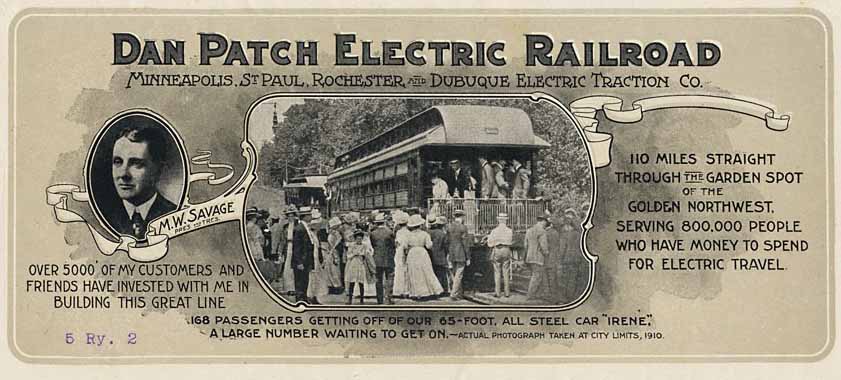
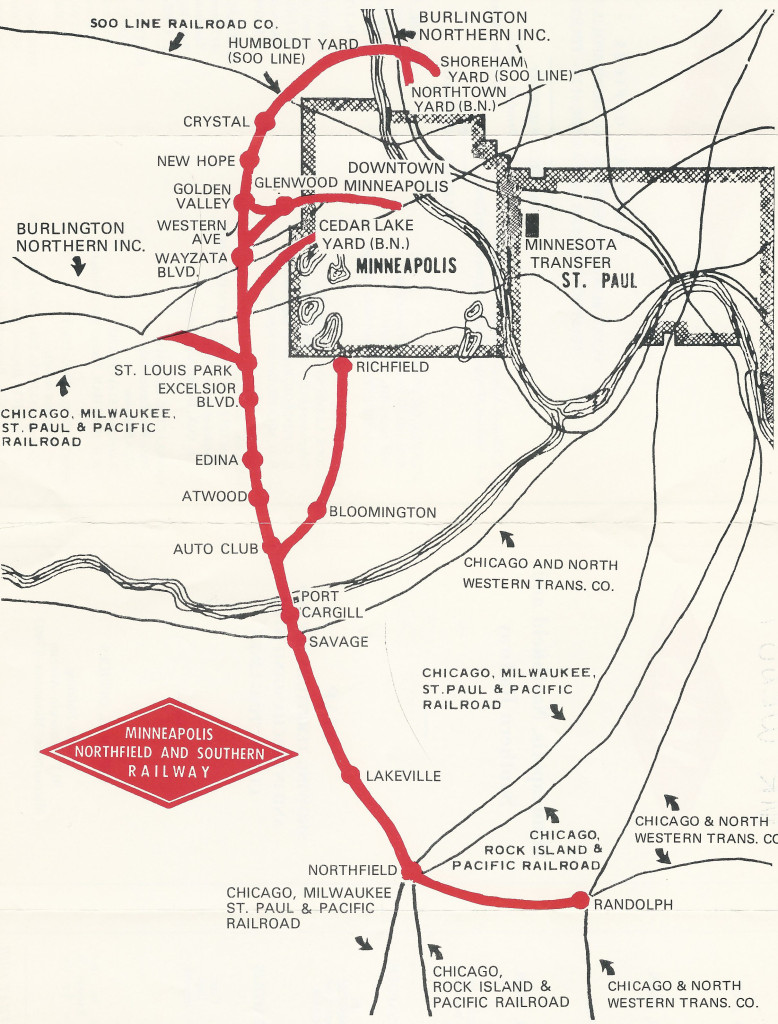
1911
Hanft:
After reaching Northfield in 1910, Savage had expected to continue his line south, but the people of Faribault refused to give the necessary right of way through the town. Later trackage was leased from the Chicago North Western to the towns of Mankato and Faribault. But the fact remained that in the early years, total cost per mile had been $150,000 and the passenger rate never exceeded 2 cents per mile.
The Minneapolis Journal of September 21, 1911, reported that special trains ran from 54th Street to Savage for harness horse race enthusiasts to attend the races at Savage’s International track. “Allow thirty-five minutes from union depot.”
1912
On February 25, 1912, the Minneapolis Tribune reported that employees of the Dan Patch were seen conducting surveys in the vicinity of the Brookside neighborhood in St. Louis Park. Although some of the surveyors indicated to onlookers that they had been hired by the Dan Patch, General Manager D.F. Smith denied that the company was interested in an extension into St. Louis Park. Some residents even suspected that landowners themselves had hired the surveyors in order to boost the value of their land.
The Minneapolis Tribune of April 7, 1912, read “Dan Patch Line Seeking Entrance Into This City.” The paper reported that the surveys “took in the territory to the south and west of the road’s terminal at Washburn Park, passed through St. Louis Park, and terminated a the main line of the Minneapolis and St. Louis road which reaches Minneapolis by way of the Cedar Lake and Kenwood district. At that point the plan was to continue the line to St. Louis Park, then leave and use the Minneapolis and St. Louis rails into Minneapolis. That did not happen. “A rumor that the Dan Patch line might purchase the Electric Short line was quieted by the announcement that there have not been, nor are there at present any negotiations on for the purchase of that property.” [Instead, the Dan Patch ended up leasing that line.]
The April 7 article also announced that the Dan Patch had ordered $100,000 worth of passenger cars, plus 21 new freight cars. The summer schedule called for 18 trains each day between Minneapolis and Northfield.
As for Faribault, the line was graded to within three miles of the city, and the company expected service to Faribault and Owatonna to begin that summer. This, too, did not happen quite as planned.
Other news was a refreshment booth at the terminal at 54th and Nicollet and the installation of an electric light plant at Antlers Park. It took 40 minutes to get from the terminal to the park.
The Minneapolis Tribune reported on June 11, 1912, that the Luce Line had purchased 19 1/2 acres of land in Minneapolis for the purpose of building “mammoth” passenger and freight terminals. This purchase, added to 30 acres previously acquired, gave the company property bounded on the west by Cedar Lake Road, on the north by Chestnut Ave., on the south by the Osseo Branch of the Great Northern, and on the east by Humboldt Ave.
The June 11 article also confirmed that the Dan Patch had leased the rails of the Great Western road from Northfield to Faribault and “will eventually use the rails into Mankato.”
On July 15, 1912, after months of rumors, the Dan Patch confirmed that it had contracted to operate its cars over the Electric Short Line (ESL), popularly known as the “Luce Line.” The Luce Line ran east into Minneapolis, and west to Hutchinson. [In 1924 the Luce Line became the Minnesota Western Ralilway and extended to Gluek, Minnesota. Today it is the Luce Line Trail.] The Dan Patch would connect to the Luce Line at Glenwood Park [now Theodore Wirth Park] in Golden Valley into downtown Minneapolis.
On September 2, 1912, the Minneapolis Tribune had much to report on the extension of the Dan Patch south of Northfield:
- By November 1 officials expected the Dan Patch to be running cars into Faribault.
- The Dan Patch would cover the 14 miles to Faribault over the Great Western rails and would use the Great Western station and terminals.
- A connection to the Great Western would be built in Northfield; the right of way has been secured and grading will be started in a few days.
- The Dan Patch would build a bridge over the Milwaukee tracks at Northfield.
- The Dan Patch has a long term lease of the Great Western track from Faribault to Mankato, but operation of that line will not start until the early 1913.
- The selection of a route between Faribault and Owatonna would be made in a few days. There was a keen rivalry among towns between the two to be on the line.
The article also reported that:
- Dan Patch officials expected to have a new type and very powerful electric traction locomotive for testing that fall, similar to those used in New York.
- The Minneapolis passenger station and office building are expected to open in the spring or summer of 1913.
- The connecting line between Lake Harriet and St. Louis Park will also open in 1913. (?)
And the article quoted a Northfield businessman, who said:
We thought at first that the road would kill the town, but now we see that it was the best thing the town ever got. Women do just about so much shopping in the cities anyhow, and this new road makes it handy for all of us.
1913
THE “CUT-OFF”
St. Louis Park is located on what was known as the “cut-off” – this was the section of the Dan Patch that extended from Golden Valley south to Auto Club Junction, where it met up with the original section of the railroad – see the map above.
On April 12, 1913, the Minneapolis Tribune reported that Savage proposed to build an extension to his existing line that would connect Glenwood Park with the tracks at Auto Club Junction in Bloomington [near the clubhouse of the Minneapolis Auto Club] just before the existing line crossed the Minnesota River. Much of the right-of-way had already been obtained. Many of the land owners along the route also pledged funds for construction of the route. This would mean 17 addtional miles of line “tapping some of the most populous and richest farming sections of Hennepin county.”
On September 30, 1913, the railroad made a presentation to the St. Louis Park Village Council requesting permission to build through the Village. Representing the railroad were Dow S. Smith, General Manager; Albert Graber, Engineer; and R.T. Boardman, Attorney. The line was approved by the Council with the provisions that the fare be reduced, and that steam was prohibited.
The Dan Patch was intended to be an electric line, but the cost was prohibitive, so the cars were gas-electric. In fact, the line had the first gas-electric freight locomotive used by an American railroad.
An article in the Minneapolis Tribune dated November 2, 1913, indicated that the cut-off was currently under construction, progressing at a rate of half a mile of track per day:
The road enters the city at the intersection of Upton and Western avenues. From there it sweeps south for a short distance and then turns almost due east to the downtown terminals at Seventh Street and Second Avenue north. At only one point does it cross a city street at grade.
According to present indications, the roadbed from the downtown terminal to where the line joins the present road at Bloomington will be completed before winter sets in. The work is being carried on at five points.
An area equal to three city blocks will be devoted to freight and passenger terminals and to yards. Although the main yards will not be located at this point, there will be room for some 50 freight cars on the downtown tracks.
Golden Valley, St. Louis Park and Brookside, villages which have not previously had similar service, are on the new line. Since there will be no stops within the city limits, these villages will be put within a 20-minute ride of the heart of Minneapolis. It is the intention to put in effect a f-cent fare from these points.
1914
In 1914 St. Louis Park Village Council minutes note that the company was ordered not to take dirt from the middle of 41st Street between Brookside and Zarthan Avenues after a request to close that road was denied.
1915
St. Louis Park did not have a regular newspaper until 1941, but fortunately a short-lived paper called the St. Louis Park Herald was published between May and October 1915, providing a blow-by-blow account of the progress of the Dan Patch through town. Dates below that are underlined are direct quotes from the Herald.
An April 25, 1915, article in the Minneapolis Morning Tribune had much to report about the benefits soon to be afforded by the imminent Dan Patch cut-off.
This new line will be a part of the old, but it will serve a part of Hennepin County that heretofore has not had had traction service. It will traverse some of the finest farming land tributary to the city and will be so near Anderson and other pretty lakes that the opportunities for country homes will be vastly greater.
The last steel was laid a day or two ago. Steel laying was started at the Bloomington end of the cut-off and progressed at the rate of about a mile a day with a track-laying machine.
The work of ballasting will be started at once. Five weeks have been allowed for that … While the ballasting is being done other odds and ends of the work will be finished, such as highway crossings, shelter stations, and [temporary] terminal buildings [pending building of the big, permanent stations].
54 new cars have been ordered, including 45 box cars, trailer passenger cars, combination mail and express cars, a baggage car and two gas-electric motor cars.
[It is the intention to give] train service so convenient that men of moderate means can afford to live in the country and work in the city.
The Dan Patch will be a competitor of the older [streetcars at St. Louis Park and 44th Street]. The new road may have an advantage over the old is running time, as it will have fewer stops and after entering the city limits [Minneapolis] there will be no stops until the station at West Seventh is reached.
Minneapolis gains vastly … especially … to those dealing in farm produce and fruits, for the Dan Patch will stop its trains just across the street from the Central Market [in Minneapolis].
In a letter to stockholders dated April 30, 1915, Savage announced that over 8,500 customers and friends had invested in the Dan Patch.
Tracks were laid through Brookside in April 1915. Although the franchise was limited to light rail passengers, the line was originally built with 80 pounds-per-yard rails that were much more than needed.
May 6, 1915: The following article was apparently reprinted from the Minneapolis Journal; all references to the “city” mean Minneapolis.
SUBURBAN LINE OPENED; TIME TO CITY SHORTENED.
The first regular suburban train schedule over the new Dan Patch line into the heart of the city will be run May 30, giving hourly service to and from all points on the road. This run will be from the Fifty-fourth street station on the south limits of the city, south to the Auto club station, and thence north over the new line, passing through St. Louis Park and University Heights to the terminal station at Seventh street and Second avenue north. This service will be in addition to the present regular schedule of trains to and from Mankato.
New Territory Reached.
The territory covered by this new schedule is all suburban. Hitherto it has been indifferently served as to quick transportation into the heart of the city. This new train adds much to the desirability of this territory as a residential and gardening section. Points on this line will be reached from the center of the city in less time than it now takes to reach man localities well within the city limits. For example, University Club Heights will be reached in 12 minutes and St. Louis Park in 15 minutes. The fact that no stops are made at city crossings permits the trains to run within the city at 35 miles an hour. This reduces the present running time to St. Louis Park by half.
Below this article is another:
MOVED NEARER TO CITY.
St. Louis Park Now Comes Into the Fifteen-Minute Zone.
The new Dan Patch line brings St. Louis Park into the fifteen-minute zone, reckoned by running time from the center of the city. And it will enjoy a five-cent fare. This quick transportation adds interest to that village as a home for people whose business is in Minneapolis. If one will take the city map and draw a line running through those points now reached in fifteen minutes by street cars, he will see what an appreciable distance St. Louis park has become toward the downtown district.
May 13, 1915: The Dan Patch depot is to be built next to the Walker building, a half block from waiting station. Also: The Dan Patch have again located their camp in Brookside. They know a good place when they see it.
May 20, 1915: Dan Patch crews are working day and night en an endeavor to complete the line by May 30.
DAN PATCH IN ST. LOUIS PARK
May 29, 1915: The new section of the Dan Patch opened for service. It comprised 14 miles of track from Auto Club Junction to Glenwood Park just outside Minneapolis in Golden Valley, and 3.3 miles of track leased from the ESL, from Luce Line Junction to a terminal in downtown Minneapolis jointly owned by the Dan Patch and the ESL.
Passenger service along the cut-off consisted of seven trains daily between the new downtown Minneapolis terminal and Mankato, and hourly service between Auto Club Junction and the downtown terminal.
Two self-propelled cars provided the transportation from Minneapolis to Savage through St. Louis Park. No formal stops were established, but the car could be flagged down to pick up or discharge passengers. A train went through St. Louis Park into Minneapolis every morning between 8:00 and 9:00 am, and and returned to Savage between 5:00 and 6:00 PM.
ROUTE
Within St. Louis Park, the Dan Patch crosses:
- Wayzata Blvd.
- Cedar Lake Road
- The Burlington Northern (formerly Great Northern) Railroad
- 28th and Blackstone
- Brunswick Ave.
- Wooddale Ave.
- Lake Street at Library Lane
- Walker Street
- Highway 7
- Lake Street
- The Twin Cities and Western (formerly Milwaukee Road) Railroad
- 39th and Brunswick Ave.
- Alabama Ave.
- Excelsior Blvd.
- 41st St.
- 42nd St.
- Brook Lane
- Brookside Ave.
ST. LOUIS PARK STEAMS
On June 3, 1915, the company appeared before the Village Council and requested permission to use steam trains to haul freight, both of which were contrary to the village charter. The request was turned down because of the added dirt and noise. At that time the railroad was asked to secure stops at Excelsior Blvd., Goodrich Ave., Minnetonka Blvd., Superior Blvd. (Highway 12), Cedar Lake Road, Lake Street, Broadway (Walker Street), and Brookside Ave. Although the request was turned down, the railroad continued the abuse until the Village served it with an injunction.
June 10, 1915: Quite a little time was used [at the Village Council meeting of June 3] in discussing the petition of the Dan Patch line to change the village franchise so as to allow them to use steam trains in hauling freight. Naturally a great amount of opposition was arrayed against such a change, as the property on their right of way was sold by the owners with the distinct understanding that no steam drawn cars would be used on this line – and it did seem a little ill-advised to ask for such a change within a few days after starting the line. The proposition was finally referred to the proper committee to report at a future meeting.
June 17, 1915: It is reported that the officials of St. Louis Park have complained to the State Warehouse and Railroad Commission against the recent proposal of the Dan Patch line to use steam locomotives for hauling freight. The commission says it has no authority to interfere.
The steam debate would go on into the 1920s.
June 24, 1915: The Dan Patch has begun improving their highway by establishing their camp just off Lake Street.
July 1, 1915: Final construction work on the cut-off was completed.
On July 14, 1915, Raymond L. Gillette crashed his automobile into the rear car of a Dan Patch train at the Excelsior Blvd. crossing. Although he was not thrown out of the vehicle, he was unconscious at the scene. As the best transportation at the time was the train itself, he was loaded on board and taken to the 54th and Nicollet station and thence to Asbury Hospital. Doctors said that his injuries were not serious.
On July 31, 1915, it was reported that the Dan Patch’s fledgling freight operations were greatly enhanced when it completed interchange arrangements with the five steam railroads to which it was connected. In St. Louis Park, the north-south Dan Patch had connections to the east-west lines:
- Minneapolis and St. Louis (now the bike trail)
- The Milwaukee Road, with switchbacks in Skunk Hollow
- The Great Northern
August 5, 1915: Clarence Lewis has announced that he is now agent for the Dan Patch. You can get your tickets at the confectionery store in the brick block [Charles Hamilton’s General Store on Walker Street].
September 16, 1915: The Dan Patch track raised an inch yesterday on the Broadway [Walker Street] crossing. The Dan Patch company are going to start next week to build a depot and warehouse at the park.
On December 5, 1915, construction of the freight house at the Minneapolis terminal was completed and served as a temporary passenger station pending completion of the actual passenger station.
1916
Without the Council’s approval, the Dan Patch started to run steam trains to haul freight in 1916. The trains were noisy and left behind black, oily smoke that clung to laundry hanging in back yards.
TROUBLE BREWING
On July 12, 1916, Marion Savage died following surgery, one day after his beloved horse, Dan Patch, died.
On July 16, 1916, after defaulting on an interest payment, the Dan Patch went into receivership. The secretary of the company attributed the insolvency to the expenses involved in operating a leased line, constructing a downtown Minneapolis terminal with the ESL, and building the cut-off from Golden Valley to Auto Club. Unable to continue making the payments necessary to use the tracks into Minneapolis and the downtown terminal, the line lost its access to the city’s business district. Passenger service continued to the Nicollet Ave. and 54th Street terminal, where passengers could transfer to streetcars, during the receivership, but it was greatly reduced. Most of the passenger equipment (8 of 11 motor cars and 17 of 19 trailers) was sold.
As for freight traffic, the Nicollet and 54th Street terminal was too far from the center of the city to make it suitable for freight, and it was essentially abandoned during the receivership. Much of the freight equipment was sold, including six of seven locomotives.
In August 1916 the receiver of the Dan Patch petitioned the Minnesota Railroad and Warehouse Commission to relieve the Dan Patch from the provisions of its franchise for a 20 rides for $1 fare between Minneapolis and St. Louis Park. The receiver asserted that the rates were “confiscatory.” On August 30, 2016, the Chairman of the Commission said that it could not legally change the provisions of the franchise, and the receiver would have to take up the matter with St. Louis Park. (Minneapolis Tribune, August 31, 1916)
1917
On December 18, 1917, a sale of the line’s assets was held as ordered by the U.S. District Court. The only bidder was a committee of the line’s bondholders, which entered a bid for the cut-off and the right to dismantle and sell the cut-off in order to recover some of their investment. The court took no action on the bid.
1918
THE DAN PATCH IN PERIL
The March 7, 1918, Minneapolis Tribune reported that the bondholders of the Dan Patch were preparing to have the rails of the cut-off torn up and sold for scrap. On December 18, 1917, the court had ordered the cut-off sold to the bondholders for $100,000, and the bondholders, most of them from the East, figured they could get $125,000 from selling the rails. But as of March 7, 1918, the court had repeatedly delayed confirming the sale.
In the meantime, the Dan Patch Patron’s Protective Association and the Dan Patch Committee of the Minneapolis Civic and Commerce Association formed a reorganization committee, initially intent on purchasing the cut-off but then aiming to purchase the entire line.
The American Traction Company proposed to purchase the cut-off if the patrons along the line could come up with $30,000 in pledges. W.L. Luce sent a telegram to American Traction saying that an arrangement could be made for the Dan Patch trains to use the Luce Line tracks into its terminal at Seventh Street and Third Ave. North in Minneapolis. Charles M. Andrist, Vice President of American Traction, said that “property owners not only feel that to junk the line will mean a financial loss to them, but, as public spirited citizens, they do not want the news to go out from Minneapolis that the first modern suburban road into the city is to be torn up. Patrons and property owners also have apprehensions that if the bondholders junk the cut-off they may find it such a satisfactory means of getting their money that the entire line from Minneapolis to Northfield may be torn up.”
The paper announced that patrons would hold a meeting at the Brookside Park station (presumably Thompson’s Store on Brookside Ave.) on March 8, 1918, to induce property owners to sign pledges. The St. Louis Park Commercial Club announced it would take up the matter at a meeting the following Monday. “St. Louis Park will be seriously affected if the road is torn up, officers of the club assert. The Dan Patch cut-off runs directly through this suburb.”
MINNEAPOLIS, NORTHFIELD AND SOUTHERN
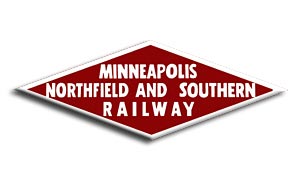
On June 21, 1918, members of the reorganization committee incorporated the Minneapolis, Northfield, and Southern Railway (MN&S) in South Dakota.
On July 31, 1918, the Minneapolis Tribune reported:
Dan Patch Line to Be Steam Railroad
Franchise Chases Permitting Move to Be Taken Up With St. Louis Park
The conversion of the Minneapolis, Northfield and Southern railway into a steam road will be attempted at once, it was announced yesterday after a meeting of directors at the Minneapolis club. Harlan P. Roberts… stated last night that certain franchise changes in the grant made by St. Louis Park to the old company would be requested at the meeting of the village board tomorrow night.
For some time past steam locomotives have been utilized in the St. Louis Park yards of the company, but Mr. Roberts said that it was merely at the sufferance of the residents there. The new company is said to be averse to this form of management and desire an agreement with the village of St. Louis Park permitting them the unrestricted right to the use of steam locomotives.
Gas electric engines and steam locomotives constitutes the motive power of the road at the present time. It was said yesterday that no attempt to electrify the road could be made during the war as electrical supplies are used extensively by the United States government and the Allies and they cannot be obtained at present.
Minneapolis, Northfield and Southern railway freight trains come into Minneapolis over the Luce Line, but the company’s own right of way will be utilized in the near future, it was said yesterday. A tri-weekly freight service is now in operation.
On August 6, 1918, the MN&S acquired the assets of the Dan Patch.
On November 18, 1918, freight service resumed into the downtown terminal, as reported by the Minneapolis Tribune. The new owners successfully marketed the reconstituted railroad as a bridge line around the congested Twin Cities freight yards. Wishing to erase the memory of the line’s previous financial troubles, the new owners also endeavored to change the name from the Dan Patch to the Northfield Southern. It didn’t stick.
On November 25, 1918, passenger service resumed into the downtown terminal.
On December 1, 1918, a timetable indicates that there were two northbound and two southbound trains daily, with two additional northbound and southbound trains on Sunday. Also in December 1918, the Brookside Ave. Station was renamed Thompson, after Thompson’s Store, 4348 Brookside Ave.
1920
The building at 5916 Excelsior Blvd. was built right next to the Dan Patch tracks. This iconic location has housed a steady stream of eateries and night clubs since at least 1920, if not earlier, including the El Patio and up to the present Bunny’s Bar and Grill. At the time, before Highways 100 or 7, the only road would have been Excelsior Blvd., which would have been of questionable quality and available to the few who had automobiles. It makes sense that the Dan Patch made it possible for people from Minneapolis to come and drink “cold coffee” and listen to jazz by such greats as Lester Young. Be sure to read about this important spot in St. Louis Park history.
1921
On October 4, 1921, the MN&S petitioned the Minnesota Warehouse and Railroad Commission to discontinue passenger service (flag stop) at the Thompson station. The petition was approved effective November 10, 1921. Service was discontinued sometime between July 17 and November 20, 1921.
The railroad also wanted to eliminate the stop at University Club Heights, which was somewhere between Park Manor and Wayzata Blvd. on St. Louis Park’s North Side – perhaps where the MN&S has a junction with the Great Northern. The request was withdrawn after attorney O.M. Peabody objected at a hearing on October 4, 1921.
Steam was still an issue in 1921: minutes from the October 15 meeting of the South Side (Brookside) Civic Club read:
On Motion it was decided that Street Car Committee circulate petition asking Council to see that the Northfield Southern Railway abide by the terms of their Franchise and discontinue using steam.
1922
Some mysterious motions by the South Side (Brookside) Civic Club: February 14, 1922:
The Secy. was instructed to write to Mr. J. Dooly, (unreadable) Mgr. of Mpls. Northfield & Southern Ry. asking that a (Show?) order be put in effect from the first crossing north of the old Brookside crossing to Excelsior Blvd.
March 15, 1922:
A Motion was made and seconded that the president instruct the council committee to make a thorough investigation relative to the Minneapolis Northfield and Southern Ry (unreadable) franchise and as to what action if any can be taken to have the right of way changed or what can be done.
St Louis Park had officially gone to court on December 6, 1922, to stop the MN&S from using steam. The Minneapolis Tribune reported that after a hearing in district court the judge gave attorneys on each side a week to prepare briefs.
1927
A six-mile extension north from Golden Valley to Crystal was completed on August 27, 1927, when railroad president Harry E. Pence drove in the last spike. The $500,000 stretch made it possible to send large shipments over the MN&S, avoiding congested traffic areas, reported the Minneapolis Tribune on September 1, 1927. The line would now connect with:
- The Minneapolis, St. Paul and Sault Ste. Marie Railroad, better known as the Soo Line, at their Shoreham yards, and
- The Northern Pacific Railway at their Northtown yard.
1942
The MN&S had attempted for years to abandon its passenger service, as the increasing use of automobiles and bus service led to the cost of providing rail passenger service to exceed revenues. On February 18, 1941, the Minnesota Warehouse and Railroad Commission held a hearing and finally approved the line’s request to discontinue passenger service.
The Minneapolis Morning Tribune reported that the last passenger service run was made on April 30, 1942. There were only eight passengers on this last run.
Freight traffic continued, and served such companies as:
- Creamette
- John Deere
- Allis Chalmers
- Ziegler
- Ford
- General Motors
- St. Regis
- Toro
- Masonite
- General Electric
1943
The MN&S operated “three or more” round trips a day between Minneapolis and Northfield, with train lengths up to 90 cars.
1956
St. Louis Park High School was built just a block from the MN&S tracks.
1959
The MN&S intensively promoted industrial development along its lines, but 70 percent of its traffic consisted of very lucrative “bridge” traffic – cars originating on other railroads being routed around Minneapolis and St. Paul. Train lengths were held to 60 cars and speeds were kept low because of the rolling terrain.
1982
On June 2, 1982, the MN&S was acquired by the Soo Line Railroad, which operated it as a separate railroad
1986
The MN&S was merged with the Soo Line on January 1, 1986.
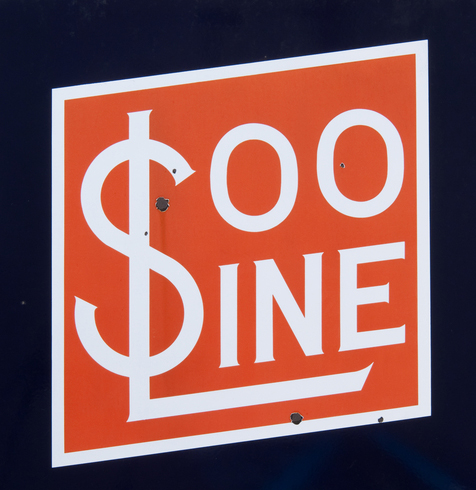
1990
The Soo Line was absorbed by the Canadian Pacific in 1990. Freight and grain cars are brought from southern Minnesota to St. Louis Park. There is a switching yard in Skunk Hollow, behind Methodist Hospital, that allows the railroad to transfer the cars to the east-west tracks of the Twin Cities and Western Railroad.
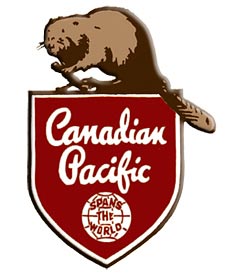
2009
In response to customer requests for larger freight deliveries in single cars, bridges over Minnetonka Blvd. and 44th Street were rebuilt to accept heavier cars.
No matter the current owner, many people still refer to this railroad icon as the Dan Patch.
DAN PATCH THE HORSE
At the turn of the last century harness racing was a big sport and the most famous horse was Dan Patch. The dark brown pacer was born in Indiana in 1896. In 145 races, he lost only two. He was so fast that other owners would not race against him. At expositions he had to race against the clock. He was racing against the clock when he set the world record of a 1:55 minute mile at the Minnesota State Fairgrounds on September 8, 1906. It was the first of 14 times breaking the world’s record. It took 32 years for his record to be broken. He was a merchandising phenomenon, with his name on cars, toys, cigars, coffee, and even a washing machine. Here is a song about him, date unknown. Dan Patch retired from racing in 1909.
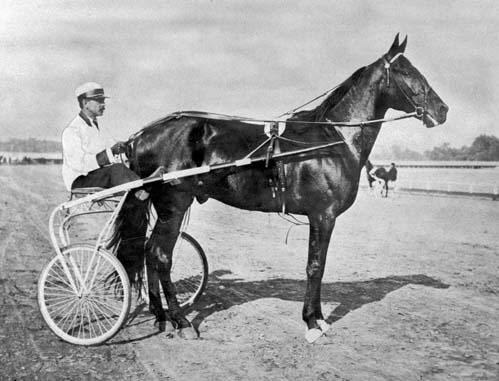
For M.W. Savage and Dan Patch there were two private cars. Dan Patch traveled in a converted baggage car painted white with gold lettering. His grooms wore white uniforms and traveled with the horse. The second car was for Savage and his family.
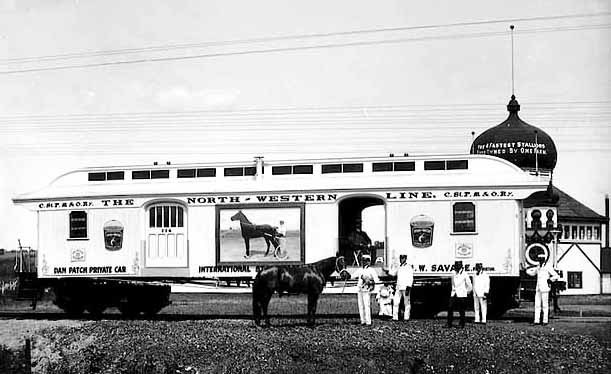
Dan Patch died on July 11, 1916, and they say Savage died of a broken heart the next day. A movie was made about Dan Patch in 1949.
Dan Patch may have had another connection to St. Louis Park. Some remember a racetrack in the vicinity of Webster/Xenwood. Mrs. Ora Baston remembers Dan Patch being trained at a track “in the heart of the Park.”
MARION W. SAVAGE
Colonel Marion M.W. Savage was born on March 26, 1858, in Marleborough, Ohio, and grew up in West Liberty, Iowa. He came to Minnesota in 1886 at the age of 27. He became wealthy as the owner of the International Stock Food Company in Minneapolis, which manufactured and sold animal feed and veterinary supply products. The 18-acre factory employed 425 people.
In December 1902 Col. Savage purchased Dan Patch for $60,000. Savage used his beloved trotter as advertising for this company, promoting Dan Patch wherever he appeared. During the holidays, Savage would hitch Dan Patch to a cutter and deliver presents to poor children in Minneapolis. Savage was known for his clean living and earned the nickname “Parson” for always wearing a black frock coat and not racing on Sundays. He was a member of the Hennepin Ave. Methodist Church, and records show that Dan Patch was a registered member as well, keeping an offering pledge with his winnings!
SAVAGE, MINNESOTA
In 1902 Col. Savage began to purchase 750 acres of land along the south side of the Minnesota River in a town that had originally been called Hamilton. It was renamed after the Colonel in 1904. Dan Patch lived like a king in Savage, in a heated barn called the Taj Mahal. The middle was dome shaped and had four wings extending from it, one of which led to an enclosed half-mile track for winter training. Dan’s stall was a showpiece with straw up to his knees and even a mirror and pictures on the wall. The complex also included a one-mile outdoor track.
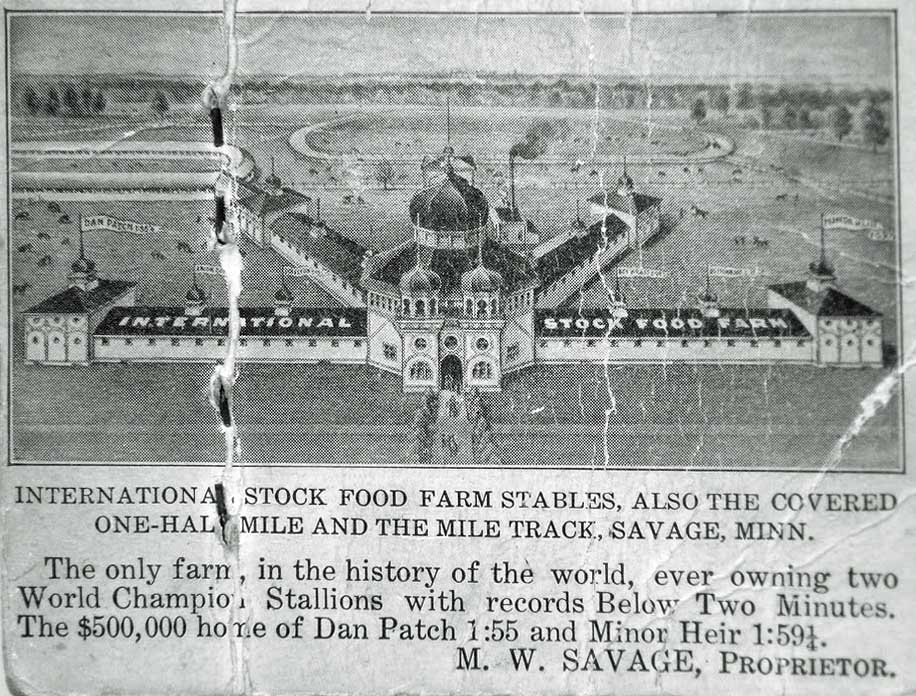
Residents of St. Louis Park will be surprised to find that Savage has many of the second-alphabet street names as the Park. We were told that the city adopted the “Minneapolis grid” in 1979, but those street names were generated in St. Louis Park in 1933!
SOURCES
- Much valuable information from the Minneapolis Morning Tribune was accessed through the ProQuest database. This information is now available on the Minnesota Historical Society website.
- Daniel Grobani has done considerable research into the Dan Patch in Brookside.
- St. Louis Park Herald, 1915
- Edina Historical Society
- Bloomington Historical Society
- Minnesota Historical Society
- Doug Johnson pulled together a Timeline based on several sources.
- Rose Ann Hanft wrote a touching memoir of the Dan Patch and Antlers Park.
- Both Johnson and Hanft cite “The Dan Patch Line,” by Navarro Fosse, Railroad Magazine, August 1943.
- Johnson cites Electric Railways of Minnesota, Russell L. Olson, 1976.
- Minutes of the South Side Civic Club
- St. Louis Park Village Council Minutes
- Dan Patch Historical Society, Savage
